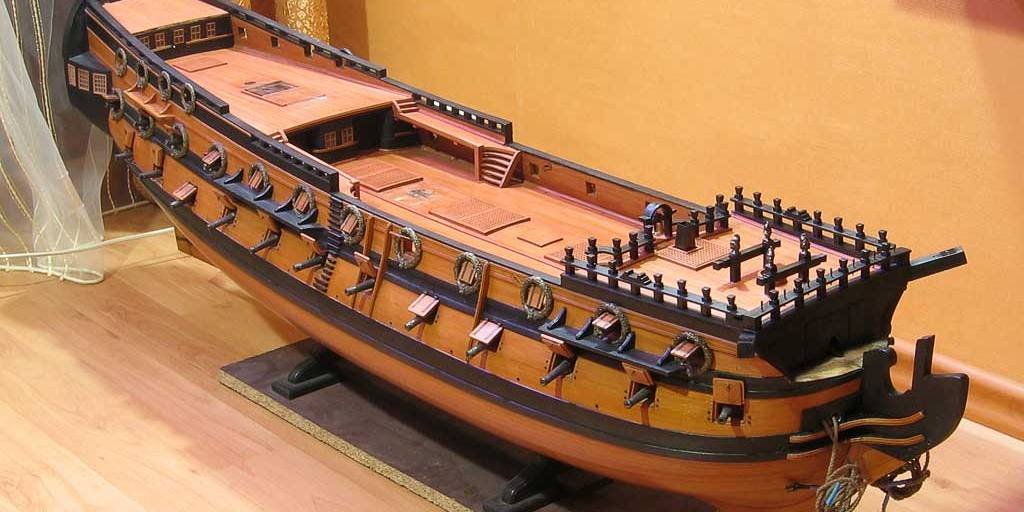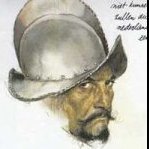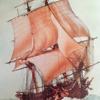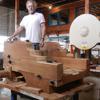-
Posts
226 -
Joined
-
Last visited
Reputation Activity
-
 igorcap reacted to Mahuna in Heroine 1838 by ggrieco - FINISHED - Scale 1:24 - Western River Steamboat as she appeared before hitting a snag in the Red River
igorcap reacted to Mahuna in Heroine 1838 by ggrieco - FINISHED - Scale 1:24 - Western River Steamboat as she appeared before hitting a snag in the Red River
Fantastic work, Glenn. I always look forward to seeing your progress.
-
 igorcap reacted to ggrieco in Heroine 1838 by ggrieco - FINISHED - Scale 1:24 - Western River Steamboat as she appeared before hitting a snag in the Red River
igorcap reacted to ggrieco in Heroine 1838 by ggrieco - FINISHED - Scale 1:24 - Western River Steamboat as she appeared before hitting a snag in the Red River
Sorry to be out of touch for the last few weeks. A couple family events, a defensive driving course and a run-in with the norovirus has kept me from posting. I'm still dragging along with the second model as well. This week I did manage to plank most of the boiler deck and half of the hurricane deck. Just for fun I decided to jump ahead to the capstans.
A capstan was not found on the wreck but the hole in the deck for one was found. Heroine's capstan must have been removed some time before wrecking because a small plank was nailed over the hole. Below is Kevin's idea of what her capstan might have looked like.
Whelps fresh off the mill.
Parts of the trundelhead.
I used a boxwood plug to hold the three parts of the trundelhead together for soldering.
Brass parts ready for blackening.
Completed capstan minus the pawls and pawl rims.
Completed cabin stove. Sorry - a little dusty. I never see the dust until after I take the photos.
Boiler deck partially planked. Starting on the Hurricane deck.
Starboard side of Hurricane deck planked. Heroines hurricane deck was covered with tarred canvas. Once planked I with cover the deck with silk and paint it black.
-
 igorcap reacted to Mike Y in Beavers Prize 1777 by Mike Y - 1:48 - POF - Hahn style
igorcap reacted to Mike Y in Beavers Prize 1777 by Mike Y - 1:48 - POF - Hahn style
Experimenting with different ways to make a smooth arc-shaped curves, like for deck beams. Right now I need it for the transom, but the methods are the same, and should be used later for beams.
Luckily I have a "template" of a proper curve - laser cut beams from the timbering set.
Clamped that template to the mill, shaped the outside curve on a disk sander, and the inside curve - by slowly feeding the wood against the mill cut. Shallow passes..
It sort of works, but the main problem is making sure the wood is sliding along the template without twisting. Right now I do it with the fingers, one finger to the left of the cutter, one to the right of the cutter. Does not work very good - the chance of mistake or a wrong move is quite high, and the risk of injury is high.
I got some nicks and dents:
Nicks could be removed by sanding later on, but that kills the idea of precision milling. So I need some sort of tension that will allow to slide the wood against the template.
Or maybe I just use the wrong approach. Will try a method described in TFFM (also on a mill, but the template shape is different). Would appreciate some advices!
-
 igorcap reacted to Mike Y in Beavers Prize 1777 by Mike Y - 1:48 - POF - Hahn style
igorcap reacted to Mike Y in Beavers Prize 1777 by Mike Y - 1:48 - POF - Hahn style
Progress is very slow, spent just an hour in the workshop
Installed remaining counter timbers. Transom is quite skewed, so impossible to achieve a proper symmetry - but I hope I will hide most of it when planking one side of it. The goal is to align windows on planked side with the counter timbers on the unplanked one.
Now fairing the timbers, the outermost counter timbers had a wrong angle.
File is good enough for it:
Btw, found a very nice scalper saw blades in the local hobby shop, was positively surprised! They could be found by "model craft saw set" query, and exist in two types.
-
 igorcap reacted to Mike Y in Beavers Prize 1777 by Mike Y - 1:48 - POF - Hahn style
igorcap reacted to Mike Y in Beavers Prize 1777 by Mike Y - 1:48 - POF - Hahn style
Thanks Glenn, Cap'n Poison and Mike!
Worked on those pesky counter timbers and helm port.
Lots of meaurements, doubts and re-measurments involved!
Step 1: carefullty mark counter timbers location. I should admit that my transom is not very symmetrical - few mm here and there. Nothing really big, and one should have a really sharp eye to see it in person, but the ruler does not lie Will measure better next time!
So a lot of time was spent trying to find a right balance to ensure symmetry in the scope of a single side. Asymmetric planking (one side planked, one side exposed) will help as well. Cardboard templates ftw!
Careful viewer will note a mistake #1 here - helm port is for the rudder, not for the sternpost. Luckily I spotted it next morning.
Lesson learned - do not do marking and measuring of such difficult areas at night, being tired. It is a recipe for disaster.
Helm port piece was cut on a bandsaw and the weirdly angled hole was first cut in the mill, and then fine shaped with files:
Then the whole assembly glued together:
Mistake #2 - the assembly is too weak, there is only one thin "bridge" keeping two sides together. Combine it with the grain following the stress line, plus counter timbers providing leverage - expected result - it snapped into two parts right in the middle. Ouch!
Glued them back together, and it not very visible. It snapped before final sanding, so it was possible to use lots of glue and sand away any traces of it from the surface. Hope it will not become apparent after applying the finish.
Assembly ready for installation:
Mistake #3 - I have not pre-cut notches in the wing transom, doing it in place. Hull sides make it impossible to properly use chisel, the angle is too square.
So used a tiny one plus knife:
End result is so-so, I am not happy with the fit, there are small gaps in the glue joints, but I did not to spend few weeks doing that part again... It would not be too visible below quarterdeck. I hope! At least the counter timbers ended up square and in line with already installed timbers. Phew!
Obligatory "light and shade" shot:
-
 igorcap reacted to Mike Y in Beavers Prize 1777 by Mike Y - 1:48 - POF - Hahn style
igorcap reacted to Mike Y in Beavers Prize 1777 by Mike Y - 1:48 - POF - Hahn style
Started a work on counter timbers and transom, Hahn jig allows to build it pretty early, since all counter timbers would be glued to the jig and there is a little chance of damaging them.
Oliver Cromwell has a pretty weird counter timbers / windows framing.
On most of the other models I saw, counter timbers follow the lines of the hull and transom wings.
For example, here is a Remco's Kingfisher (http://modelshipworld.com/index.php/topic/18-hms-kingfisher-by-remco-1770-english-14-gun-sloop-pof-148):
In my case, however, both NMM drawing and Hahn's interpretation of it show that windows (and, hence, counter timbers) are basically square and vertical, and do not follow the hull shape:
I already made transom wings following the dotted line on these drawings, which follows the shape of the hull. Now I have only one realistic option - make counter timbers evenly spaced and end up with framing similar to the other models of this period (like Swan class). And windows will not be as square as they are on Hahn's model. So be it. Or I am missing something obvious in this problem? Would apperciate a second look, I might be misinterpreting all that drawings?
In a meanwhile, made some assisting construction to help with alignment of the counter timbers. True redneck engineering! But better than nothing:
And made the counter timbers themselves. Left group is a second-tier, where I made few mistakes (joints with gaps, etc). It will go to the planked side of the model where all these mistakes would be covered.
The right group are a prime timbers that would go to the exposed side of the hull. So good to have a side where all mistakes would be hidden!
-
 igorcap reacted to druxey in Beavers Prize 1777 by Mike Y - 1:48 - POF - Hahn style
igorcap reacted to druxey in Beavers Prize 1777 by Mike Y - 1:48 - POF - Hahn style
The Beaver's Prize draught is contemporary and, one presumes, 'taken off' accurately for the Admiralty. Therefore rectangular (or almost rectangular) lights were representative of her as captured. Note that the timberheads above are angled inward. Therefore the counter timbers were angled at the level of the deck above the lights. For a model, these might be easier added as separate items later on. Remember that Hahn did stylize his models, this being one example.
-
 igorcap got a reaction from JosephHuntley in Head figure for Oliver Cromwell
igorcap got a reaction from JosephHuntley in Head figure for Oliver Cromwell
Probably every modeller wants to build a model in the Navy Board style. In 2004 I started to model the American privateer Oliver Cromwell in 1/48 ( original built in 1776). Model is built on drawing from Harold Hahn's book "Ships of the American Revolution and their models". The model is not completed at this time.
-
 igorcap reacted to Mike Y in HMS Naiad 1797 by albert - FINISHED - 1/48
igorcap reacted to Mike Y in HMS Naiad 1797 by albert - FINISHED - 1/48
Super! Every time you update the log, I want to write that - but need to stop myself to avoid polluting it too much
Your build quality (and speed) is hard to match!
-

-
 igorcap reacted to Mirabell61 in HMS Naiad 1797 by albert - FINISHED - 1/48
igorcap reacted to Mirabell61 in HMS Naiad 1797 by albert - FINISHED - 1/48
Beautiful work in wood for a beautiful ship Albert,
Nils
-

-
 igorcap got a reaction from KORTES in Brig Mercury rigging by Igor Capinos
igorcap got a reaction from KORTES in Brig Mercury rigging by Igor Capinos
Hello everybody! I finished 3D model rigging of the brig Mercury.
Only rigging and sails
-
 igorcap got a reaction from Archi in Brig Mercury rigging by Igor Capinos
igorcap got a reaction from Archi in Brig Mercury rigging by Igor Capinos
Hello everybody! I finished 3D model rigging of the brig Mercury.
Only rigging and sails
-

-
 igorcap reacted to ggrieco in Brig Mercury rigging by Igor Capinos
igorcap reacted to ggrieco in Brig Mercury rigging by Igor Capinos
Igor, I have been admiring your 3D models for awhile now. I just wish I had your ability. As an engineer, I have no problem modeling mechanical parts but I'm amazed at your combination of engineering and truly artistic skills. I would love to be able to model a figurehead to mill but, I just have trouble with organic shapes. Your 3D models are incredible.
-
 igorcap reacted to BobF in The Rogers Collection of Dockyard Models, Volume I
igorcap reacted to BobF in The Rogers Collection of Dockyard Models, Volume I
Hello all,
Many good things have already been stated concerning this excellent book. I hope you don't mind if I add a few more.
BobF
The Rogers Collection of Dockyard Models
At the U.S. Naval Academy Museum
First & Second Rates
Volume I
by Grant H. Walker
Distributed by: Sea Watch Books, LLC, Florence, Oregon
www.seawatchbooks.com, seawatchbooks@gmail.com
In his opening remarks, the author, Grant Walker, states that it took eleven years to assemble the information that is the basis for The Rogers Collection of Dockyard Models, Volume I, and the several future volumes that are planned. There is no doubt that from the naval historian’s and ship modeler’s perspective, it was well worth the wait!
In this initial volume, Walker describes, in detail, the results of his research on the seven Royal Navy three-decker 1st and 2nd rate ships contained in the collection. These models represent vessels that served from the mid 17th century into the 19th century, and, needless to say, they are magnificent!
This is the first comprehensive study of Roger’s models since 1946, when the Naval Academy published a pamphlet outlining the entire collection. Revised editions were printed on four occasions, but only the photographic content was changed. In every case, the illustrations were in black and white.
In what will be the standard approach for all the volumes in this series, each featured model is described in detail, along with its provenance, and a brief history of the actual ship or class that the model represents. Every segment begins with a table that offers comparisons between the dock yard model and the vessel the model represents. In some cases, the Establishment applicable to the model’s period of representation, is incorporated into the tables.
The first model discussed is the impressive First Rate, Britannia, 100 guns (1682/1700). Walker immediately adds intrigue by stating that there is considerable reason to doubt whether this model is actually Britannia. He offers compelling reasons why this may be the case, in spite of the many visual elements that compare favorably with contemporary images, and the ship’s name appearing above the topgallant roundhouse entrance.
As is the case with the other models in this book, a detailed construction analysis is provided. It includes CT scans, X-rays and numerous below-deck photos taken with an arthroscope.
The next model presented by Grant Walker is the Second Rate St. George, 90 guns (1701). Although comparable to Britannia in terms of guilt ornamentation, it is the model’s remarkable suite of original masts, yards and rigging that set this Second Rate apart from other contemporary dockyard pieces, including those featured in this book. Nevertheless, Walker opts to concentrate on the actual ship’s history, as well as the model’s provenance, and construction details, which feature numerous below deck photos.
Several excellent illustrations of the St. George’s rigging, accompanied by brief descriptions, are provided, but Walker prefers to defer to the two classic works by Dr. R. C. Anderson, for those interested in learning more about warship rigging during this period.
The next chapter features an unidentified British Second Rate Ship, c.(1715-1725). Based on the model’s provenance, this may be the most controversial model in the Annapolis Collection.
Extensively restored in 1923 to include the upper decks, quarter galleries, masts, yards, rigging and decoration, this dock yard model is a far cry from its original appearance when purchased by Colonel Rogers. Walker’s explanation for the controversy, as well as his efforts to identify, and rationalize the appearance of the model, makes for some great reading!
Although referred to as Model No. 39 in the Rogers Collection, the British First Rate Royal William, 100 (1719) was actually the first dockyard model purchased by Colonel Rogers.
The provenance of this magnificent ship model is unknown prior to the Twentieth Century. Yet, the author provides an intriguing, and somewhat bizarre, tale of how Royal William was eventually obtained by Rogers. The subsequent detailed analysis of this model, accompanied by a wealth of outstanding photographs is worth the cost of this book by itself!
The author states that Model No. 70, the British Second Rate Princess Royal, 90 (1773) is considered one of the finest examples of the ship modeler’s art in the collection. Yet, as little as twenty years ago, this remarkable piece was literally falling apart.
An extensive rebuild by Rob Napier, which is the subject of another SeaWatch book, brought this beautiful model back from the brink of disaster. The story of this model’s provenance is most noteworthy, while the photos of the frieze work and carvings are exceptional, to say the least.
Apparently, contradictions among models as old as those in the Rogers Collection are quite common, and the British Second Rate Duke, 90/98 (1777) is no exception.
Grant Walker provides some intriguing theories concerning the construction of this impressive model. Arguments are also provided that in spite of some notable facts to the contrary, this Second Rate does indeed represent the Duke. Also, a rarity among British models in the collection, is the full set of furled sails this model features.
The British First Rate Royal Adelaide, 110 (1828) is the most recently built model showcased in Volume 1, and it is probably the most radical. The unique bow and stern are discussed in detail, with a contemporary diagram of the stern gun arrangement being provided by the author.
Walker’s analysis of the slipway and ingenious case will leave the reader amazed. He also explains why, in spite of the First Rate’s rock-solid provenance, this model still presents a few mysteries.
The book concludes with six appendices. They are Dockyard Models Defined, Colonel Roger’s Biography, Charles Sergison (a previous owner of Rogers Collection models), Scales & Measurements, Caretakers of the Collection, and a brief explanation of the collection’s Catalog Numbers system.
The Rogers Collection of Dockyard Models, Volume I, features an oversized 11 3/4x10 format with hundreds of high definition photos, printed on quality paper. This book is a remarkable achievement, and would be an excellent addition to the library of any maritime historian or model ship builder.
-
 igorcap got a reaction from Omega1234 in Heroine 1838 by ggrieco - FINISHED - Scale 1:24 - Western River Steamboat as she appeared before hitting a snag in the Red River
igorcap got a reaction from Omega1234 in Heroine 1838 by ggrieco - FINISHED - Scale 1:24 - Western River Steamboat as she appeared before hitting a snag in the Red River
Super professional work !
-
 igorcap got a reaction from albert in Brig Mercury rigging by Igor Capinos
igorcap got a reaction from albert in Brig Mercury rigging by Igor Capinos
Hello everybody! I finished 3D model rigging of the brig Mercury.
Only rigging and sails
-
 igorcap reacted to ggrieco in Heroine 1838 by ggrieco - FINISHED - Scale 1:24 - Western River Steamboat as she appeared before hitting a snag in the Red River
igorcap reacted to ggrieco in Heroine 1838 by ggrieco - FINISHED - Scale 1:24 - Western River Steamboat as she appeared before hitting a snag in the Red River
Thanks Frank, Cathead, druxey, Igor and Albert for your comments and everyone for the likes.
Cathead, I hope you decide to do Arabia. I look forward to following the build! I wanted to point out a mistake I made in my reply to your last post. I mentioned an illustration of Delphine with stairs from the boiler deck to the pilot house and Yellowstone without. It was just the opposite. I should know better than to trust my memory. Sorry for confusing the two.
Druxey, yes, it no longer looks like a motel. Definitely an important feature but, on Friday I was looking at the view from the pilot house out over the bow. It is amazing how much of the view is obstructed by the two chimneys. I can see how a snag might sneak by without being detected.
-

-
 igorcap got a reaction from NJQUACK in Brig Mercury rigging by Igor Capinos
igorcap got a reaction from NJQUACK in Brig Mercury rigging by Igor Capinos
Hello everybody! I finished 3D model rigging of the brig Mercury.
Only rigging and sails
-
 igorcap got a reaction from Alcedo in Brig Mercury rigging by Igor Capinos
igorcap got a reaction from Alcedo in Brig Mercury rigging by Igor Capinos
Hello everybody! I finished 3D model rigging of the brig Mercury.
Only rigging and sails
-
 igorcap got a reaction from ggrieco in Heroine 1838 by ggrieco - FINISHED - Scale 1:24 - Western River Steamboat as she appeared before hitting a snag in the Red River
igorcap got a reaction from ggrieco in Heroine 1838 by ggrieco - FINISHED - Scale 1:24 - Western River Steamboat as she appeared before hitting a snag in the Red River
Super professional work !
-
 igorcap got a reaction from WackoWolf in Heroine 1838 by ggrieco - FINISHED - Scale 1:24 - Western River Steamboat as she appeared before hitting a snag in the Red River
igorcap got a reaction from WackoWolf in Heroine 1838 by ggrieco - FINISHED - Scale 1:24 - Western River Steamboat as she appeared before hitting a snag in the Red River
Super professional work !










